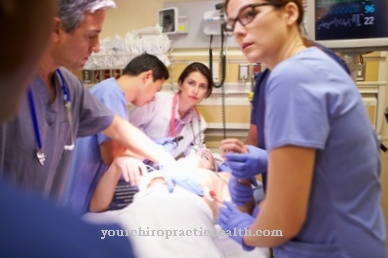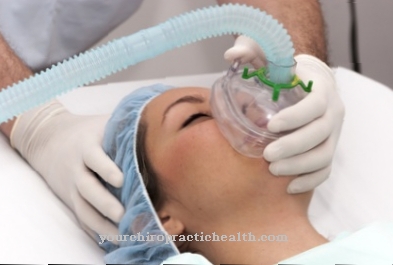When breathing stops, the brain is no longer supplied with sufficient oxygen. The first brain cells die after a short time. Cardiac arrest occurs two to three minutes later. Therefore, act quickly with the help of the Cardiopulmonary resuscitation required when respiratory and cardiovascular arrest has been detected.
What is cardiopulmonary resuscitation?

The Cardiopulmonary resuscitation or cardiopulmonary resuscitation aims to supply the blood with oxygen through ventilation and through a Chest compressions build up blood pressure. In this way, vital organs such as the brain can be adequately supplied with oxygen. This creates the basis for the ambulance service to get the heart going again with the help of medication and defibrillation.
In cardiopulmonary resuscitation, a distinction is made between basic measures, which can also be carried out by laypeople as part of immediate life-saving measures, and extended measures.
Function, effect & goals
A Cardiopulmonary resuscitation is carried out in emergencies in which respiratory or cardiovascular arrest has occurred. For the latter, sudden cardiac death is the most common cause. This can be caused by cardiac arrhythmias, strokes, heart attacks or also external factors such as accidents, suicide attempts, allergic reactions, foreign bodies in the airways, poisoning or electric shocks.
Basic cardiopulmonary resuscitation measures can be used by laypeople as well as by professional medical personnel. This includes recognizing cardiac arrest, calling the emergency number, clearing the airways and the actual resuscitation measures such as chest compressions and ventilation. The use of an automated external defibrillator is also one of the basic measures for cardiopulmonary resuscitation.
Cardiac arrest can be recognized by the fact that the person concerned is not conscious, not breathing, has no vital functions and has no pulse. Other signs include pale appearance and a blue discoloration of the lips. Before cardiopulmonary resuscitation, the patient should be lying flat on their back and ensure that the airways are clear. Foreign bodies, vomit or dentures must be removed from the oral cavity. The so-called life-saving handle (see also: Stable lateral position) ensures that the airways are kept free.
To do this, the patient is grasped by the chin and forehead and the head is carefully bent back by lifting the chin. As soon as it can be assumed that the person is not breathing, even if there is no absolute certainty, cardiopulmonary resuscitation should be started immediately.
Carrying out cardiopulmonary resuscitation as a combination of chest compressions and mouth-to-mouth or mouth-to-nose resuscitation can be carried out by emergency witnesses who are trained and who are confident enough to do this.
Adult resuscitation begins with 30 presses on the sternum, followed by two one-second ventilation and then another 30 chest compressions. The rhythm of 30 chest compressions and two breath donations applies regardless of whether one or two helpers are present. For cardiopulmonary resuscitation of children, five respiratory donations are started and resuscitation is then continued at a ratio of 30: 2.
Checks should be made every one to two minutes to see if cardiopulmonary resuscitation is working.Cardiopulmonary resuscitation should be performed until the person begins to breathe on their own again or until the emergency doctor arrives.
Cardiac arrests are often associated with ventricular fibrillation. This condition can be canceled by an electric shock. The chances of success are greatest in the first minute. Cases with defibrillation devices can be found more and more often in underground stations and in busy public places on walls or pillars. These AED devices, AED stands for automated external defibrillation, work fully automatically. Voice instructions lead from one movement to the next. Therefore, these devices for cardiopulmonary resuscitation can also be operated by laypeople.
Risks & dangers
The Cardiopulmonary resuscitation is not entirely without dangers. Ribs or sternum fractures and liver and spleen injuries can occur in the patient.
In addition, air or blood can penetrate the pleural space between the pleura and the lungs (pneumothorax or hemothorax). Cardiopulmonary resuscitation can also cause blood to enter the pericardium (pericardial tamponade) or vomiting and aspiration.
Despite these risks, cardiopulmonary resuscitation should be started as soon as possible in an emergency. It is the only way to provide effective help to those affected. If you wait until the rescue service arrives for fear of the consequences, they have little chance of doing anything for the patient.






.jpg)


















.jpg)

.jpg)
